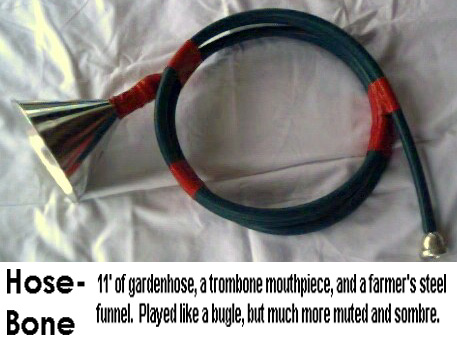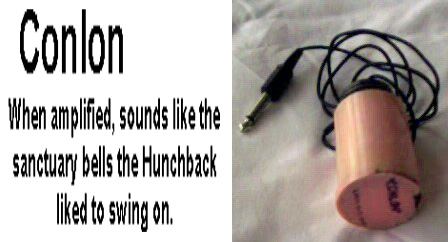My Homemade (and other) Odd Instruments [in delicto]
by Bret (not the wrestler) Hart
The great thing about a homemade or unfamiliar instrument is that no one can accuse you of playing it improperly. I have found that the playing of them breaks me of lazy habits developed over time on traditional instruments; and continually places me in a situation which requires, and sharpens, active-listening. Strange instruments are a discipline I impose on myself in order to broaden my pallette; a great growth-vehicle for the improvisor's ears. Fate has repeatedly brought me in contact with makers of such instruments, and players to whom their sounds were not unwelcome. I recently saw a newspiece on television about a fellow who can make a violin out of anything, and wished I'd caught his name.
I enjoy traveling outside the confines of the culturally disintegrating US, and wherever I've gone, I've found strange and beautiful native instruments; themselves every bit as different (in sound and aspect from the 'Western' instruments with which most Americans are only familiar) as any of these 20th century homemades. Non-Western culture is, I find, pure and inspiring.
In Korea, where I lived and translated for four years during the 80's, I quickly ascertained that shops catering to Buddhists were goldmines of neat percussion instruments. There, I obtained gongs, bells, bizarre wooden percussion instruments, etc. Friends who travel have brought back some wonderful things; the Taiwanese kweng (a harmonica of sorts), an electric saz from Turkey, a Vietnamese moon-lute (kai-dan-nguet), a Mexican quatro, and others. The Strum-Stick and the Can-jo are little known stringed
anomalies of American origin. I keep my eyes peeled for forgotten American instruments, such as the fully functional circa-1925 banjo-ukelele I found for $60 last year, hanging despondently on a dusty display wall.
My interest in 'foreign' sounds probably all traces back to the experiments with controlled- feedback I was doing between 1975-79 in my parents' basement. I wanted to determine the extent to which one could manipulate feedback in a live context. I made numerous flutes from American bamboo in the late 70's while an undergraduate in New York State's North Country. Our porch and property have a load of homemade windchimes, woodchimes, and other wind-triggered things that
go "clank", "bonk", and "ding" scattered about; probably to the dismay of our neighbors on blustery days.
I have been experimenting with self-made instruments ever since encountering the sonic-inventions of Hans Reichel, Fred Frith, and Eugene Chadbourne twenty years ago. In the trunk of my wife's car is the first Rake that Eugene Chadbourne built, given to me by Bob Jordan a few years back. The one, I believe, which was used on Shockabilly records. It still 'works'. When I discovered the music of Harry Partch, I felt I'd died and gone to Heaven. My microtonal composer friend, Dan Stearns, continues that tradition from his Cape Cod home.
What follows are descriptions of the instruments I can remember making. Some, just didn't work out. Several, I cannot remember well enough to accurately describe. Cognitive deletion,
y'know? JOE and THE HOWLER were the satisfactory end-products of quite a few failed attempts to simulate Asian stringed instruments. Others happened because spare parts suggested ideas worth experimenting with. As for common objects, if it sounds interesting, it's probably worth attaching a contact mic to. Ok.
"BEND-GUITAR" (1984
- Monterey, CA)

My first homemade electric stringed instrument, had been an solid body
electric Hagstrom 12-string guitar. It took the concept of whammy-bar to
an exaggerated conclusion. I used a bandsaw to:
[A] shape the guitar-body into a long slab and
[B] cut it in half behind the pickup, but ahead of the bridge
...and then reattached the two halves with a big gate-hinge on the
backside of the instrument.
The frets were extracted from the neck. The Bend-guitar
was a polyphonic, electronic percussion instrument; played using 'traditional'
left-hand guitar technique [chordal-'fretting', bends/ hammer-on/off, sliding
notes and chords, etc] and a combination of traditional and extended right-hand/arm
techniques. Pressure [toward the hip, while pulling the neck back
with the left hand] from the right forearm could be used to bend all strings
simultaneously; generally adding the fun of a new, unexpected & radically
dissonant detuning across the board. I'd seen Adrian Belew strangling
his guitar and this instrument sprang from that observation. (Extended
stretches of play, say...over 5 minutes, would reduce the tunings of all
of the strings - however many remained - to "Bill Laswell-y" blubber.)
Something went wrong once, while plugged into a Marshall stack during recording
and it short-circuited, nearly taking my fingertips with it. Shades
of Philip Lithman! Disassembled for parts in 1986. The tailpiece
is now on THE ARC.
"JOE" (1985 - South Korea)

Joe was built in my $30-per-month 'art-hootch' in Anjong-Ri, South
Korea, where I painted, wrote, and made music between 1985-1986.
It is a hardwood slab, measuring appx 7"x14" x 3/4"thick, outfitted with
two Schaller tuners on one end and string anchors on the other, 2" high
bridges on both leading edges in between, and a big Dimarzio Super Distortion
pickup right in the middle. Played with drumsticks, this tunable
minimalistic quasi-hammer dulcimer appeared on several cassette releases.
One, Mount Rushmore, has been re-released on CD on the Homemade
Music label
[ http://www.homemademusic.com/artists/brethart/
] In 1995, I gave it to Bob Jordan (notable, in
the Aural-Innovations universe, for booking Architectural Metaphor
into Gilrein's in Worcester).
"The BAT-PHONE" (1990
- Norwood, MA)

In preparation for the first Maximum Love Vibes 8-track sessions,
this faux-reverb microphone was constructed. The rubber 'stopper'
was extracted from an aluminum basebal bat, and a 1/2" hole drilled in
the end of the handle. A Shure SM-57 was inserted, cord first, into
the bat, and pulled down into the handle. We attached it to a mic-stand
using clamps, and it was sung into...sounding cavernous and creepy, like
a cartoon monster voice. The BAT-PHONE added a quavering reverb-like
quality to vocals, and appears prominently on the MLV song Shutting
The Door. It disappeared during a gig at the original Worcester
Artist Group in 1991.
"THE HOWLER" (1992 - Fitchburg,
MA)

The Howler is a 24" long, 1"x1" block of pine, with a cheesy flat plastic
pickup I got for $2 in Korea fitted into a depression a few inches in from
one end. In the center is a 2" high knife-edge bridge, and there
is a tuner for its single low-E string, which is tuned to a high tension,
though arbitrary, pitch. The line-out passes through an old MXR distortion
pedal. It is played by plucking/striking the string to the right
of the bridge, while applying pressure to the string on the other side,
bending the pitch of the sounded note. This instrument is loosely
based upon the Korean kaya-gum and Japanese koto. I still perform/record
with it in the band AUTOMATIC MUSIC.
"THE ARC" (1993 - Ashby,
MA)

Numerous strings pass through a Hagstrom 12-string tailpiece, extend
over a 4" tall bridgepiece in the center of the instrument, and collectively
terminate at a single Grover tuner at the opposite end. The body
is two Chippendale chair legs, connected by bolts and wingnuts in the center,
where they pass through the squared ends of the legs, which are adjacent
to each other. The sculpted portions extend up in an arc with a length
of about 33". A Fender humbucker is embedded in the body near the
bridge. The Arc is an electronic percussion instrument, played with
a mallet or stick. Very noisy and clamorous. You'll hear THE
ARC on an upcoming AUTOMATIC MUSIC release.
"THE ELECTRIC BOWL" (1998
- Eden, NC)

A large plastic salad bowl with contact mic. A gift to percussionist,
Scotty Irving, when we were in the post-R.I.O. group - The Rockingham County
Recyclers. Had a great, zero-sustain clunky sound, with timbral variants
on its edges and sides. It was stolen when his station wagon was
broken into. Lost a vintage Electro-Harmonix Space Drum that
day, too.
"NOT QUITE A CLARINET" (1999
- Eden, NC)

This is a Korean tae-gum; similar to the oboe, for which the bamboo
reeds can no longer be obtained. As such, unplayable until a clarinet's
mouthpiece was fitted onto it. The tae-gum has finger holes like
a recorder, rather than keys. Sounds raucous, like a goose.
"THE HOSE-BONE" (1999
- Eden, NC)

A length of garden hose fitted with a trombone mouthpiece on one end,
and a funnel on the other. Capable of doing the same general things
as a bugle, but far more silly sounding.
"BASS-BANJO" (2000
- Eden, NC)

A Kramer guitar neck attached to a 1950's Silvertone banjo body strung
with three bass strings and amplified. Requires a very heavy plectrum.
I use a compressor to beef-up the volume and add a wee bit of sustain.
This gets played in our 'avant-Appalacian' (mutant Bluegrass) band, The
Cat's Pants.
"CONLON" (2000
- Eden, NC)

This is a small, pink plastic cylindrical thing which I found attached
to the underside of an antique child's rocking chair; which made a sound
like tiny windchimes when the chair was rocked. I removed it and
affixed a contact mic to one end. Held in the fingertips and moved
in a circular motion, it produces huge bell sounds, which are controllable
to some extent. Named after the composer for player-piano, Conlon
Nancarrow. Used on the Alonzo Phillips record, FACED.
"THE ELECTRIC RAINSTICK"
(2001 - Eden, NC)
A child's toy rainstick (clear plastic with tiny colored balls inside)
with attached contact mic. Does not sound like your average rainstick,
as the individual 'tick' sounds are comparatively gigantic. Used on FACED.
"ATOMIC SLEIGHBELLS" (2001
- Eden, NC)
A small ziplock bag containing a handful of little toy 'sleighbells'
and a contact mic, wrapped in duct tape. Shaken, it sounds thunderous
- sometimes like machinery. Also on FACED.
CLICK HERE to return to the Bret Hart / InstrumenTales profile index page.
Click your browser's BACK button to return to the previous page.
Or CLICK HERE to return to the main Aural Innovations page.









